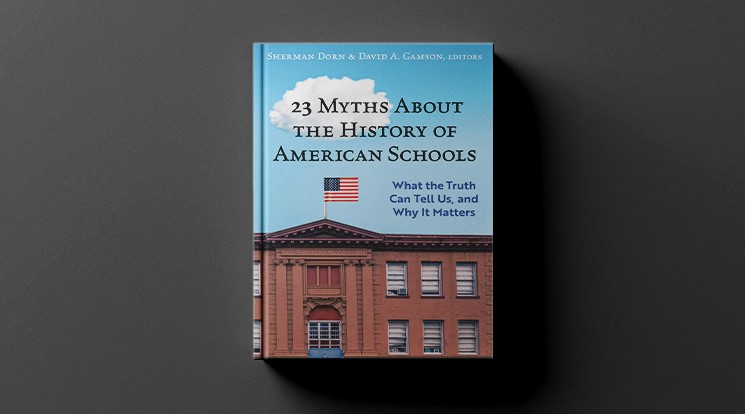Myths about the history of schools

Education has its share of myths: beliefs that there was a golden age of student behavior or academic rigor, the story of the little red schoolhouse or how summer vacation has its roots in the agrarian calendar. The problem with myths is that they tend to crumble upon further scrutiny. Arizona State University Professor Sherman Dorn, who is with the Mary Lou Fulton Teachers College, David Gamson, a professor with Pennsylvania State University and their fellow historians tackle some of these education myths in the book “23 Myths About the History of American Schools. What the Truth Can Tell Us, and Why it Matters.”
Myths can be entertaining, and also misleading, according to Dorn. “The appeal of a good myth is hard to resist. But myths can become the justification for ill-informed decisions. Persistent myths about the magical value of new technology suggest that we can avoid the hard work of understanding how schools might use or abuse technology. When someone says special people are ‘born’ to be teachers, that can become an excuse for not providing teachers with the skills and support needed for success.”
As co-editors, Dorn and Gamson categorize 23 common historical myths, each explored in chapters by education historians who analyze and assess each myth. Here are three of the myths highlighted in the book:
The myth: Our current K–12 education system is based on the Industrial Age’s approach to mass production. (Chapter written by Sherman Dorn)
The reality: It is true that single teacher, age-graded classrooms dominate elementary and secondary schools, but that is not the result of some imaginary factory model. It started because that classroom model replaced a true factory model in the early 19th century — dozens or hundreds of students in a single room with one teacher — and continues because it is flexible for schools and because schooling is typically risk-averse. In the early 19th century, the monitorial school became the official model in many American cities, which was a way for a single adult to supervise dozens or hundreds of students in a single large room by having high-achieving students lead smaller groups. This model became unpopular by those who saw it as too factory-like. Schools of any size or type could be built by aggregating single-teacher classrooms.
The myth: U.S. schools were desegregated in 1954 with the Brown v. Board of Education decision. (Chapter written by Hope C. Rias, assistant professor at Siena College)
The reality: In fact, desegregation happened in different ways and at different times in different districts. In 1954, Thurgood Marshall successfully argued before the U.S. Supreme Court that racial segregation in public schools violated the U.S. Constitution, establishing that separate schools were inherently unequal and that this violated the 14th Amendment. He was concerned that school leaders would not comply with the Supreme Court’s ruling unless they were compelled to do so, so he asked the Supreme Court to set a compliance date, and the request was declined. The Supreme Court ruled that desegregation should occur “with all deliberate speed.” Instead, compliance dragged on due to ongoing resistance in parts of the country. It took the considerable efforts of national civil rights advocates, parents and communities to push for desegregation at the community and district level. One example of these efforts is the case of Liddell v. Board of Education in 1979, a local decision in the St. Louis federal district court, that contributed to the national momentum toward desegregation, which took place a quarter century after the original Brown v. Board opinion.
The myth: Good teachers are born, not made. (Chapter developed by Kate Rousmaniere, professor emerita from Miami University of Ohio).
The reality: In the television show Abbott Elementary, a new teacher talks about the profession being a calling. That myth is a longstanding one rooted deeply in beliefs that teachers are as much agents of morality as they are skilled practitioners. The myth presumes that there is a limited skill base to the occupation and minimizes the need for continuous professional development. In reality, good teaching involves development of pedagogical skills, and a teacher’s success may be shaped by the social and economic context of students’ lives or the organizational context of schools. Most teachers in all eras have understood that teaching is complex work that requires extensive academic and professional preparation and on-the-job support.
Learn about more school myths by reading the book:
https://www.tcpress.com/23-myths-about-the-history-of-american-schools-9780807769263
https://www.amazon.com/Myths-About-History-American-Schools/dp/0807769266